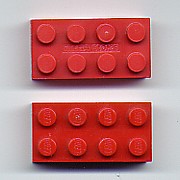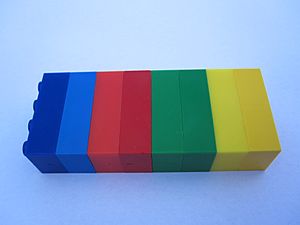Lego clone facts for kids

Have you ever played with building blocks that look a lot like Lego, but aren't actually made by Lego? These are called Lego clones. They are building toys made by other companies that fit together with real Lego bricks. The Lego Group first got a special right, called a patent, for their building bricks way back in 1961. This patent meant only they could make those specific bricks for a while. But after 1978, those patents ran out. This allowed other companies to start making their own similar building blocks.
Some companies that make Lego-compatible blocks even say their products "work with leading building bricks" to show they fit with Lego.
Contents
Legal Battles Over Building Blocks
Over the years, The Lego Group has taken many companies to court. They wanted to stop others from making blocks that looked too much like theirs. However, most of these lawsuits were not successful for Lego.
Courts often decided that the basic design of the building brick is about patents, not trademarks. A patent protects how something works or is made, while a trademark protects a brand name or logo. Since Lego's patents for the basic brick had expired, other companies were generally allowed to make similar blocks.
It's interesting to know that Lego itself got the idea for its bricks from a British inventor named Hilary Fisher Page in the late 1940s.
Early Lawsuits: Tyco Super Blocks
In the 1980s, Lego went to court against Tyco Industries in the United States. Tyco made a line of interlocking bricks called Super Blocks. On August 31, 1987, a US court said that Tyco could keep making Super Blocks. However, Tyco had to stop using the Lego name in their ads and couldn't say their blocks were "Lego, but only cheaper." Lego also sued Tyco in other countries like Hong Kong, Austria, Italy, and Canada.
Mega Bloks and the Brick Design
The Canadian company Mega Brands, which makes Mega Bloks, was also sued by Lego. Lego argued that Mega Bloks' system of "studs and tubes" (the bumps and holes that connect blocks) was a violation of Lego's trademarks.
But on November 17, 2005, Canada's highest court, the Supreme Court of Canada, said Mega Bloks had the right to keep selling their products in Canada. The European Union's court made a similar decision in 2008. Then, in 2010, the European Court of Justice ruled that the famous 8-peg design of the original Lego brick "just does a technical job" and cannot be protected as a trademark. This meant other companies could use a similar peg design.
Other Companies and Trademarks
The English company Best-Lock Construction Toys also sued Lego in German courts. In 2009, the German Federal Court said Lego could not trademark the shape of its bricks.
However, Lego did win a case in 2002. Their Swiss branch, Interlego AG, sued a Chinese company called Tianjin CoCo Toy Co., Ltd. for copying their toy sets. A court found that many CoCo sets were indeed copies. CoCo was told to stop making them, apologize publicly, and pay a small fee to Interlego.
Lego also tried to trademark its mini-figures (the small people figures). Best-Lock had been making similar figures since 1998. In 2012, Best-Lock tried to get Lego's mini-figure trademark removed. But on June 16, 2015, the European Court of Justice supported Lego's trademark for its mini-figures.
Light-Up Blocks and Packaging
In 2002, Jon Capriola had an idea for light-up blocks called Laser Pegs. He got a patent for this idea in 2009. Later, another company, LaRose Industries (Cra-Z-Art), started making similar light-up blocks called Lite Brix. Capriola's company sued them in 2013 for using his patented idea.
In 2011, Lego sued a Chinese company called Guangdong Jumbo Grand Plastic Moulding Industrial because their BanBao brand had very similar packaging. The two companies settled their case outside of court. Guangdong agreed to create unique packaging and a new figure called ToBees.
In 2016, Lego announced they would take legal action against another Chinese company, Guangdong Loongon, which makes the brand Lepin. Lepin was selling exact copies of Lego sets, including the box designs.
Brands of Compatible Blocks
Many different companies around the world make building blocks that are compatible with Lego. Here are some of them:
| Name | Figure | Years Made | Manufacturer |
|---|---|---|---|
| BanBao | ToBees | 2010–present | Guangdong Jumbo Grand Plastic Moulding Industrial Co., Ltd. |
| Bikku | 2018–present | Keak Japan Co., Ltd. | |
| Built to Rule | 2003–2005 | Hasbro | |
| Best-Lock | 1997–present | Best-Lock Group | |
| CaDA | 2007–present | Double Eagle Toys Industry Co. Ltd. | |
| Caremi Blocks | 2005-Present | Caremi Toys, Inc. | |
| Cobi | Best-Lock Group | ||
| CoCo | Tianjin COCO Toy Co., Ltd. | ||
| Kre-O | Kreon | 2011–present | Hasbro |
| Laser Pegs | Laser Pegs Ventures | ||
| Lepin | Guangdong Loongon | ||
| Lite Brix | Cra-Z-Art (LaRose Industries) | ||
| Mega Bloks | 1991–present | Mega Brands (Mattel) | |
| Make-it Blocks | ?–present | proprietary brand of Dollar Tree | |
| N&B Block | 1968-1972 | Nintendo | |
| Oxford | Oxford | ||
| Qman (formerly Enlighten) | 1994-present | Guangdong Qman Industry Toys Co., Ltd. | |
| Sluban | 2004-present | Sluban | |
| Tyco Super Blocks | 1984–1990 | Tyco Toys/Mattel | |
| Wilko Blox | Wilko | ||
| Xingbao | 2016 | subsidiary of Lepin, Guangdong Loongon | |
| Zuru MAX | Zuru |
- K'Nex sets have included compatible bricks since 2008.
- Ramagon, by Discovery Toys, has some panels with compatible studs.


